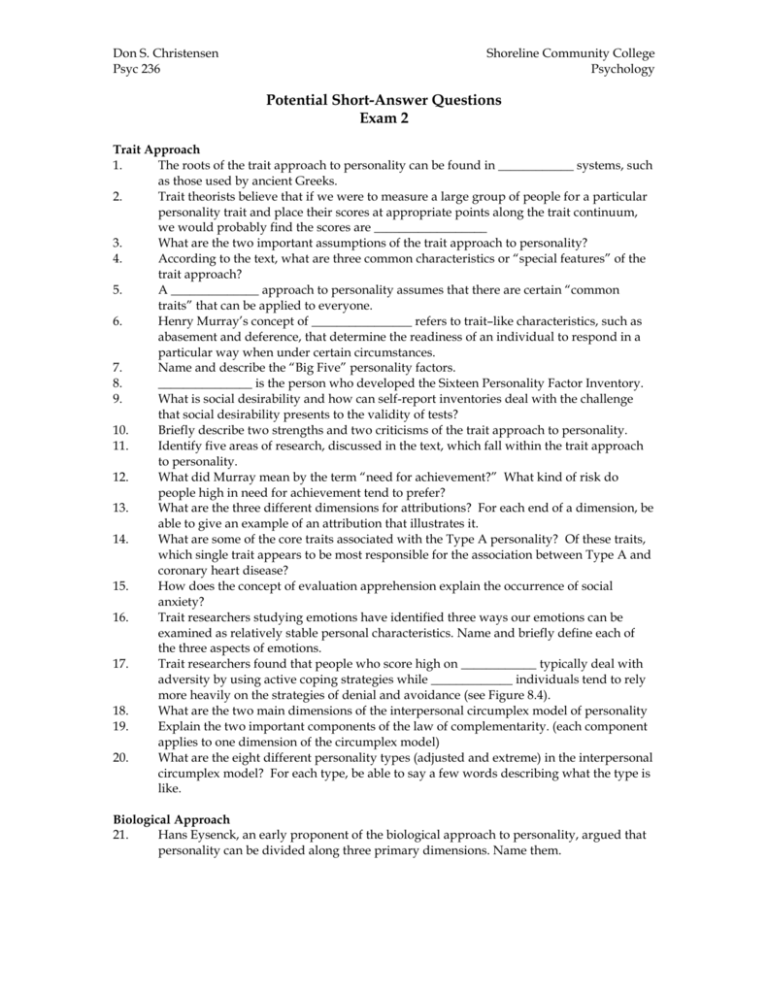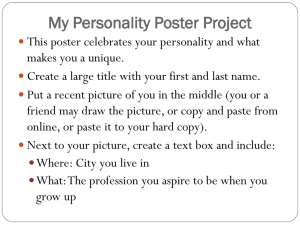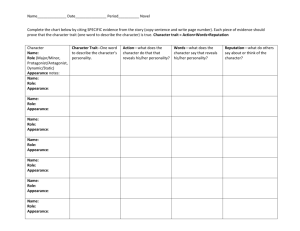doc
advertisement

Don S. Christensen Psyc 236 Shoreline Community College Psychology Potential Short-Answer Questions Exam 2 Trait Approach 1. The roots of the trait approach to personality can be found in ____________ systems, such as those used by ancient Greeks. 2. Trait theorists believe that if we were to measure a large group of people for a particular personality trait and place their scores at appropriate points along the trait continuum, we would probably find the scores are __________________ 3. What are the two important assumptions of the trait approach to personality? 4. According to the text, what are three common characteristics or “special features” of the trait approach? 5. A ______________ approach to personality assumes that there are certain “common traits” that can be applied to everyone. 6. Henry Murray’s concept of ________________ refers to trait–like characteristics, such as abasement and deference, that determine the readiness of an individual to respond in a particular way when under certain circumstances. 7. Name and describe the “Big Five” personality factors. 8. _______________ is the person who developed the Sixteen Personality Factor Inventory. 9. What is social desirability and how can self-report inventories deal with the challenge that social desirability presents to the validity of tests? 10. Briefly describe two strengths and two criticisms of the trait approach to personality. 11. Identify five areas of research, discussed in the text, which fall within the trait approach to personality. 12. What did Murray mean by the term “need for achievement?” What kind of risk do people high in need for achievement tend to prefer? 13. What are the three different dimensions for attributions? For each end of a dimension, be able to give an example of an attribution that illustrates it. 14. What are some of the core traits associated with the Type A personality? Of these traits, which single trait appears to be most responsible for the association between Type A and coronary heart disease? 15. How does the concept of evaluation apprehension explain the occurrence of social anxiety? 16. Trait researchers studying emotions have identified three ways our emotions can be examined as relatively stable personal characteristics. Name and briefly define each of the three aspects of emotions. 17. Trait researchers found that people who score high on ____________ typically deal with adversity by using active coping strategies while _____________ individuals tend to rely more heavily on the strategies of denial and avoidance (see Figure 8.4). 18. What are the two main dimensions of the interpersonal circumplex model of personality 19. Explain the two important components of the law of complementarity. (each component applies to one dimension of the circumplex model) 20. What are the eight different personality types (adjusted and extreme) in the interpersonal circumplex model? For each type, be able to say a few words describing what the type is like. Biological Approach 21. Hans Eysenck, an early proponent of the biological approach to personality, argued that personality can be divided along three primary dimensions. Name them. Don S. Christensen Psyc 236 22. 23. 24. 25. 26. 27. 28. 29. 30. 31. 32. Shoreline Community College Psychology What are the four levels of Eysenck’s Hierarchical Model of Personality? At what level in this hierarchy would you find Eysenck’s concepts of introversion-extraversion, neuroticism, and psychoticism? Define temperament. Name and briefly describe Buss and Plomin’s three dimensions of temperament. Evolutionary personality psychology uses the concept of ___________________ to explain the development and survival function of human personality characteristics. Thomas and Chess’s nine temperament dimensions led them to propose the existence of three basic temperament patterns. Name them. The __________________________ model refers to the idea that how well a child does in school (or in other environments) is partly a function of how well the expectations and demands of the learning environment match the child’s capabilities, characteristics, and style of behaving. What is one common brain measure used assess cerebral asymmetries? What kinds of asymmetries have been observed for people experiencing either positive or negative emotions? List two strengths and two criticisms of the biological approach to personality. True or False: Research examining the influence of genetics and the environment in explaining personalities suggest that genetics is by far a better predictor of personality and behavior than environment. Researchers looking at extraversion have found that extraverts tend to seek out ________________ environments and perform better in these environments. In terms of well-being, research also suggests that extraverts are generally ____________ happy than introverts. Evolutionary personality research shows that men are more likely to consider the two characteristics of _____________ and ______________ when selecting a dating partner or spouse while women have been found to prefer men with _________________. The Humanistic Approach 33. Many of the questions that later became cornerstones of the humanistic approach such as the role of free will and the uniqueness of being human were first addressed by ________________ philosophy. 34. According to the text, what are the four important criteria for classifying a theory as humanistic? 35. Describe what Rogers meant when he described people as “fully functioning.” Be able to least at least three characteristics of these people. 36. What did Rogers mean by the term “subception?” 37. Differentiate between conditional and unconditional positive regard. 38. Identify and briefly describe Maslow’s Hierarchy of Needs from bottom to top. What are two common misconceptions of this hierarchy? 39. List Csikszentimihalyi’s eight components of optimal experiences. 40. What are the three key components of a person-centered approach to psychotherapy? 41. How is the Q-Sort Technique used by humanistic psychologists to measure self-concept and change? 42. What are two strengths and two criticisms of the humanistic approach to personality? 43. What has the research of psychologist James Pennebaker revealed about the value of disclosing traumatic experiences? 44. According to research on self-disclosure, what does the rule of disclosure reciprocity refers to? 45. Define the humanistic concepts of self-esteem and self-concept. 46. Briefly describe the differences that researchers have found in the ways that people with high and low self-esteem respond to failure (see Figure 12.3). Don S. Christensen Psyc 236 47. 48. Shoreline Community College Psychology True or False: Based on his observations, Maslow concluded that virtually all psychologically healthy people have a low preference for solitude. List and briefly describe 4 (of a possible 7) positive aspects of solitude.








